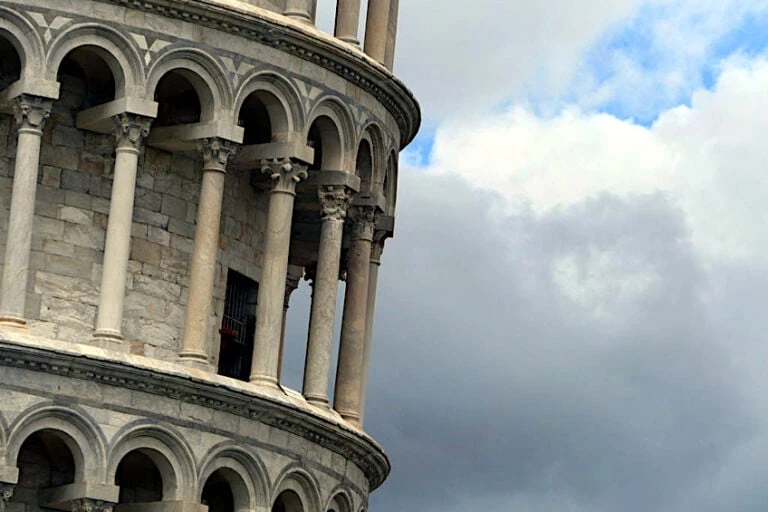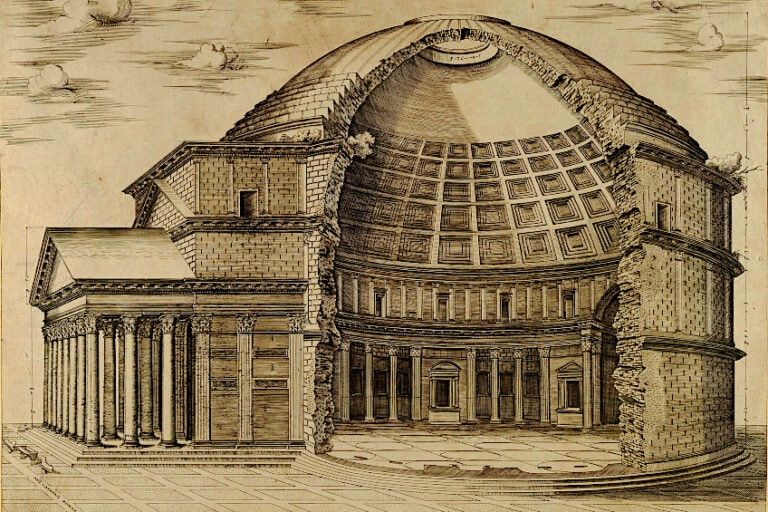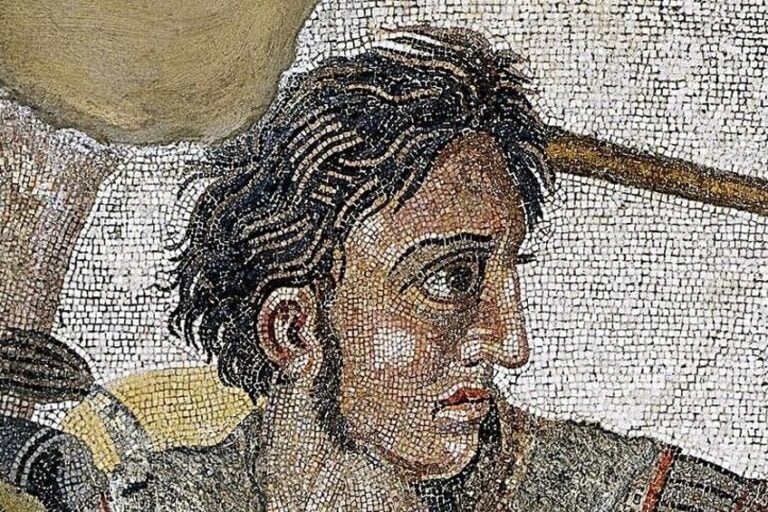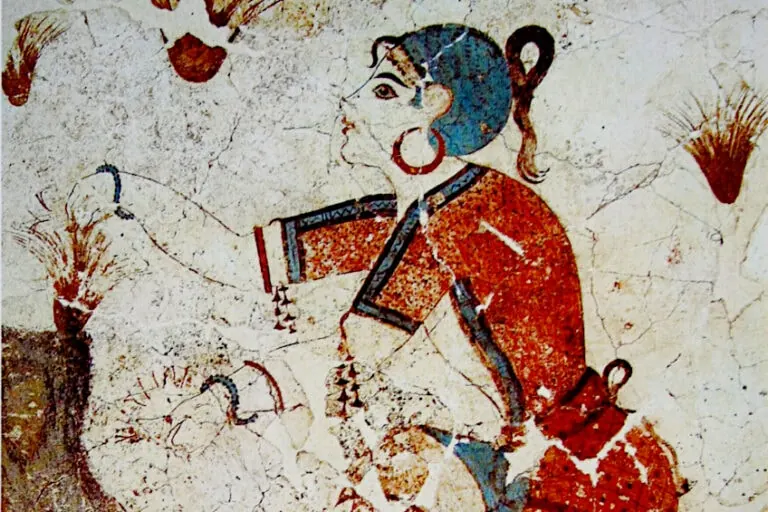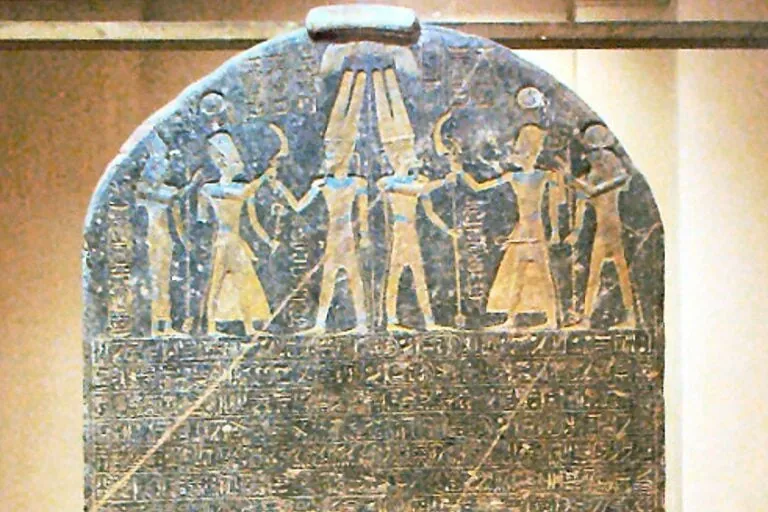Famous Greek Statues – Read Up on Ancient Greek Statues
There are many famous Greek statues that survived the many centuries between the fall of ancient Greece and the modern day. Many more were likely lost, but we can only focus on those that did manage to survive. In this article, we are going to examine fifteen of the most famous and influential ancient Greek statues. Keep reading to learn more about Greek sculpture, Greek sculptors, and some of the most famous Greek statues ever made.
Contents
- 1 15 of the Most Famous Greek Statues
- 1.1 Moschophoros (560 BCE) from the Acropolis of Athens
- 1.2 Group of Zeus and Ganymede (480 – 470 BCE) from Olympia
- 1.3 Charioteer of Delphi (478 or 474 BCE) from the Sanctuary of Apollo
- 1.4 Motya Charioteer (470 – 460 BCE) from Motya
- 1.5 Artemision Bronze (460 BCE) from Cape Artemision
- 1.6 Riace Bronzes (460 – 450 BCE) from Riace
- 1.7 Discobolus (460 – 450 BCE) from Unknown
- 1.8 Athena Parthenos (Mid-5th Century BCE) from the Acropolis of Athens
- 1.9 Statue of Zeus (435 BCE) from Olympia
- 1.10 Pediments of the Parthenon (Around 432 BCE) from the Acropolis of Athens
- 1.11 Aphrodite of Knidos (4th Century BCE) from Knidos
- 1.12 Victorious Youth (300 – 100 BCE) from the Aegean Sea Coastline
- 1.13 Winged Victory of Samothrace (200 – 190 BCE) from Samothrace
- 1.14 Laocoön and His Sons (2nd Century BCE) from Rome
- 1.15 Venus de Milo (150 – 125 BCE) from Milos
- 2 Frequently Asked Questions
15 of the Most Famous Greek Statues
The ancient Greek civilization is often considered to be one of the foundational societies that led to Western civilization as it currently stands. For this reason, many of the artistic, architectural, philosophical, political, and scientific developments that are associated with ancient Greece are similarly considered to be foundational to the history of the Western world up until the present day. Ancient Greek statues form part of this long and illustrious heritage. The designs and principles that were adopted and developed by ancient Greek sculptors have influenced Western artists for generations to come, and the influence has actually extended far beyond the Western world.
This is why we are going to examine fifteen of the most famous Greek statues to see what makes them so important.
Moschophoros (560 BCE) from the Acropolis of Athens
| Creator | Possibly Phaidimos (6th century BCE) |
| Date | 560 BCE |
| Materials Used | Limestone |
| Height | 1.65 meters (or 5.4 ft) |
| Discovery Location | Acropolis of Athens, Athens, Greece |
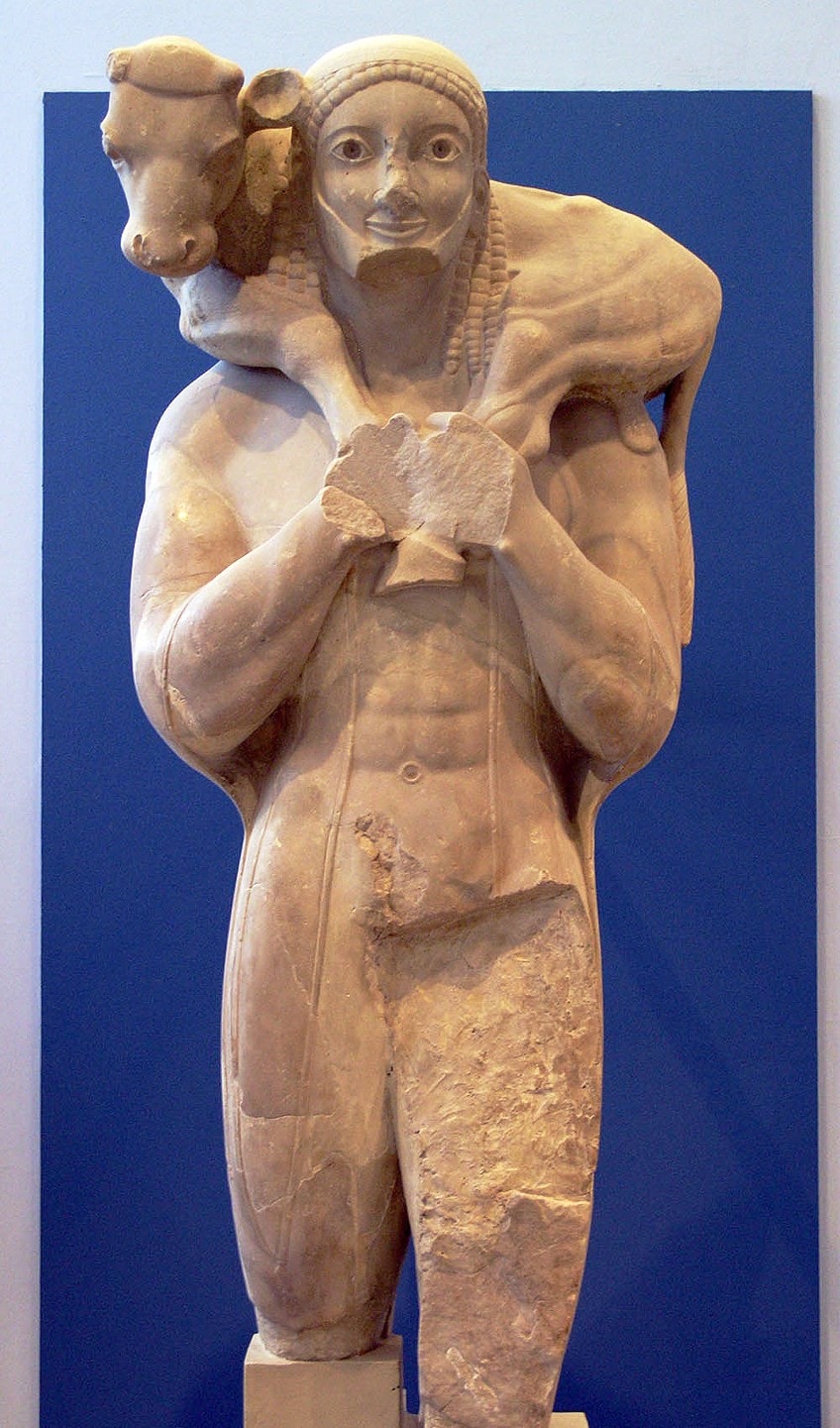 The Moschophoros or Calf-bearer; Acropolis Museum, CC BY-SA 2.5, via Wikimedia Commons
The Moschophoros or Calf-bearer; Acropolis Museum, CC BY-SA 2.5, via Wikimedia Commons
Moschophoros is an ancient Greek statue from the Archaic period. This particular statue is also known as the Calf Bearer because of the subject that it depicts. The statue shows a figure that is, as the name would suggest, holding a calf across its shoulders. The statue is one of the earliest instances of ancient Greek sculpture, and it has not quite managed to survive fully intact to the present day. It was even discovered in fragments, but the proposed full height of the structure put it at 1.65 m (or 5.4 ft). The figure that is depicted has a thick beard, which is typically considered to be an ancient Greek symbol to represent full adulthood, and the figure is also entirely naked.
This was common practice in much of ancient Greek sculpture and has become one of the most notable aspects concerning this classical form of statue design.
However, he is also depicted with a cloak, and cloaks were generally used to signify that a character was, in some way, a respectable figure. We do not know who the statue actually represents, but this is quite common for much of truly ancient sculpture that depicts non-divine or historical figures. However, this may have been the depiction of a citizen who was, in some way, wealthy enough to have a statue of his person designed.
Group of Zeus and Ganymede (480 – 470 BCE) from Olympia
| Creator | Unknown Corinthian sculptors |
| Date | 480 – 470 BCE |
| Materials Used | Terracotta |
| Height | 1.1 meters (or 3.6 ft) |
| Discovery Location | Olympia, Elis, Greece |
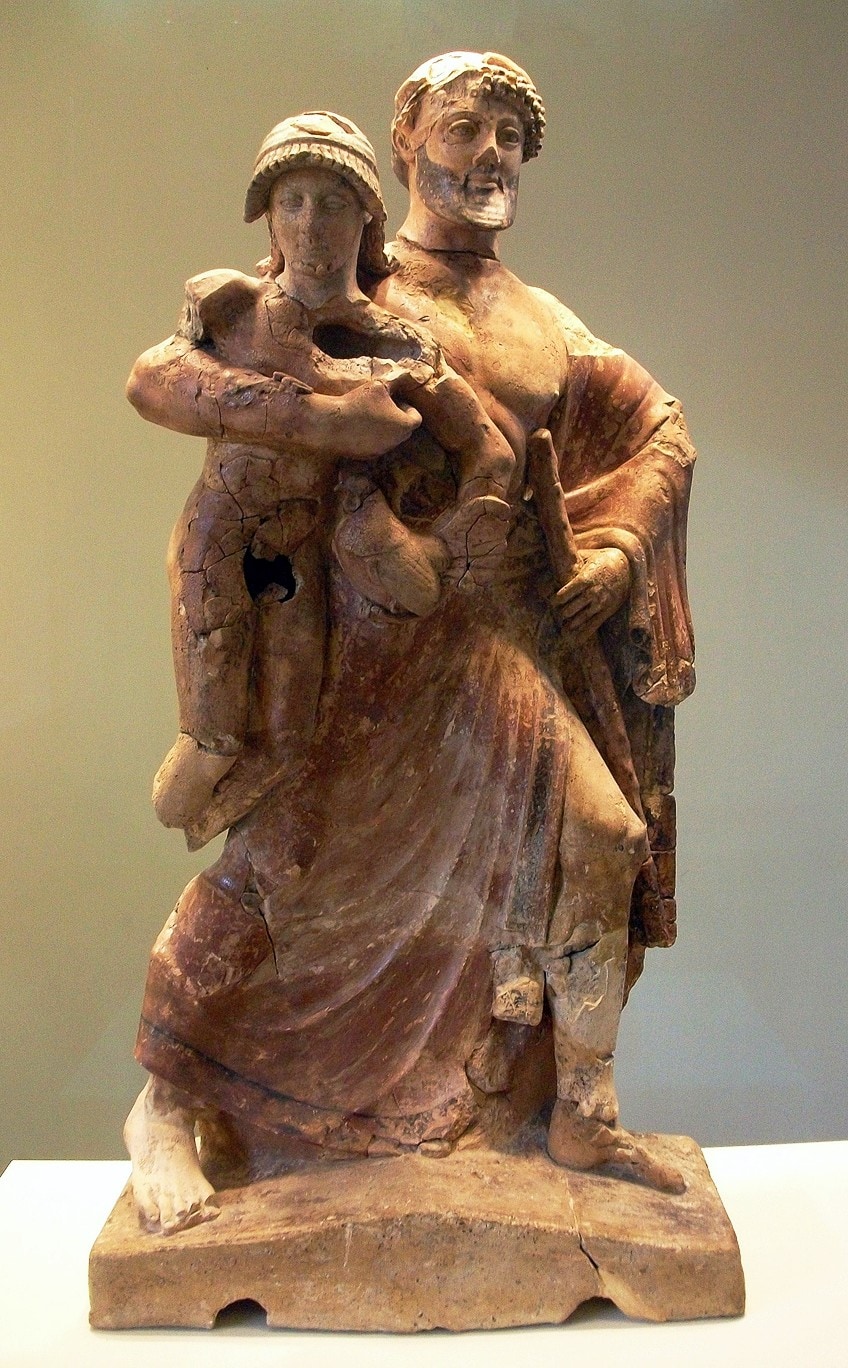 Late Archaic terracotta statue of Zeus and Ganymede, Olympia Archaeological Museum; Joanbanjo, CC BY-SA 3.0, via Wikimedia Commons
Late Archaic terracotta statue of Zeus and Ganymede, Olympia Archaeological Museum; Joanbanjo, CC BY-SA 3.0, via Wikimedia Commons
The Group of Zeus and Ganymede is a sculpture made up of multiple figures. In this case, the terracotta sculpture is descended from the Late Archaic period, and it depicts the divine figure of Zeus. In more specific terms, Zeus is depicted as carrying the figure of Ganymede, who was a character from ancient Greek myth who was taken to Mount Olympus. It is believed that this particular sculptural group was likely part of the treasures at Olympia, but this cannot be certain. What is certain is that the figures are quite strange in their general depiction.
In ancient Greek statues, figures were generally either designed to be larger than life, true to life, or far smaller than life (such as a statuette), but this particular group of statues is only slightly less than life-sized.
This issue has led to this ancient Greek artifact being a particularly strange and unique one in the history of ancient Greek statues. This particular sculpture is also one of the most famous Greek statues that does not reside in a foreign museum after being plundered in some way from its original location. Instead, the Group of Zeus and Ganymede can be found in the Archaeology Museum of Olympia, which is near where the sculpture was discovered in the first place.
Charioteer of Delphi (478 or 474 BCE) from the Sanctuary of Apollo
| Creator | Pythagoras of Rhegion (5th century BCE) |
| Date | 478 or 474 BCE |
| Materials Used | Bronze |
| Height | 1.8 meters (or 5.9 ft) |
| Discovery Location | Sanctuary of Apollo, Delphi, Greece |
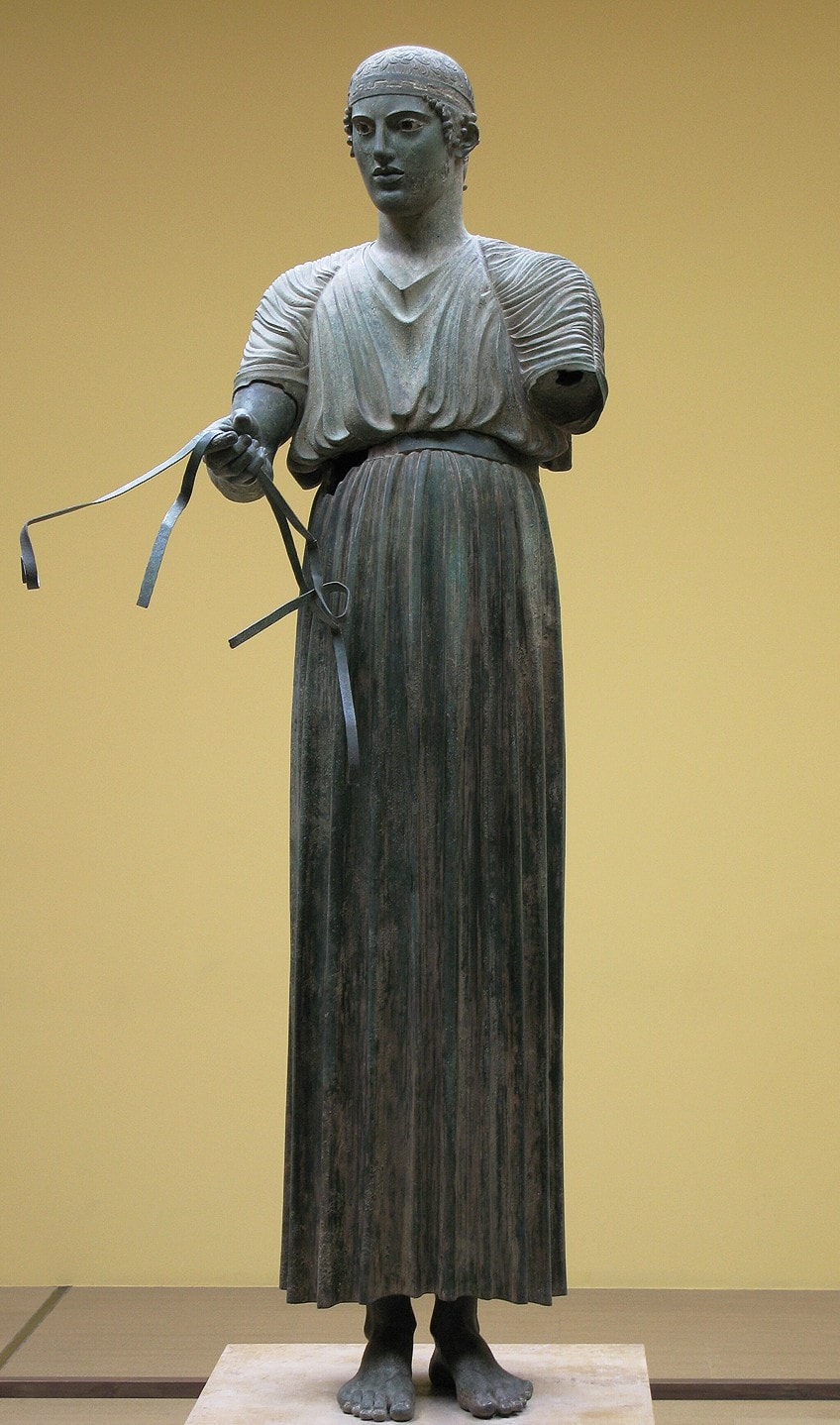 The Charioteer of Delphi, 470s B.C; RaminusFalcon, CC BY 3.0, via Wikimedia Commons
The Charioteer of Delphi, 470s B.C; RaminusFalcon, CC BY 3.0, via Wikimedia Commons
The Charioteer of Delphi is an ancient bronze statue that is also known as Heniokhos. The statue itself does not retain its full original design as part of the statue is missing, but with such ancient statues, it was not uncommon for them to survive entirely intact into the present day. In this particular case, the statue is an instance of Early Classical art in the region. The reason that it is considered to be part of the Early Classical period is because it makes use of a more naturalistic style than those often adopted in the Archaic period. However, the exact dating of anything this old can often be a difficult thing to determine with extreme accuracy.
Instead, the Charioteer of Delphi has simply attained its place as one of the most famous Greek statues, and a stunning example of the bronze sculpted form.
The subject of this particular sculpture was of a young man who was designed to appear very young. This was quite common for the period as many charioteers were notably immensely young individuals who were chosen for their lightweight physical build as it would aid in streamlining the racing process and reducing the overall weight that the horses would need to pull. In the case of this charioteer, he is not depicted within a race, but rather before or after it.
Motya Charioteer (470 – 460 BCE) from Motya
| Creator | Unknown |
| Date | 470 – 460 BCE |
| Materials Used | Marble |
| Height | 1.81 meters (or 5.9 ft) |
| Discovery Location | Motya, San Pantaleo, Sicily |
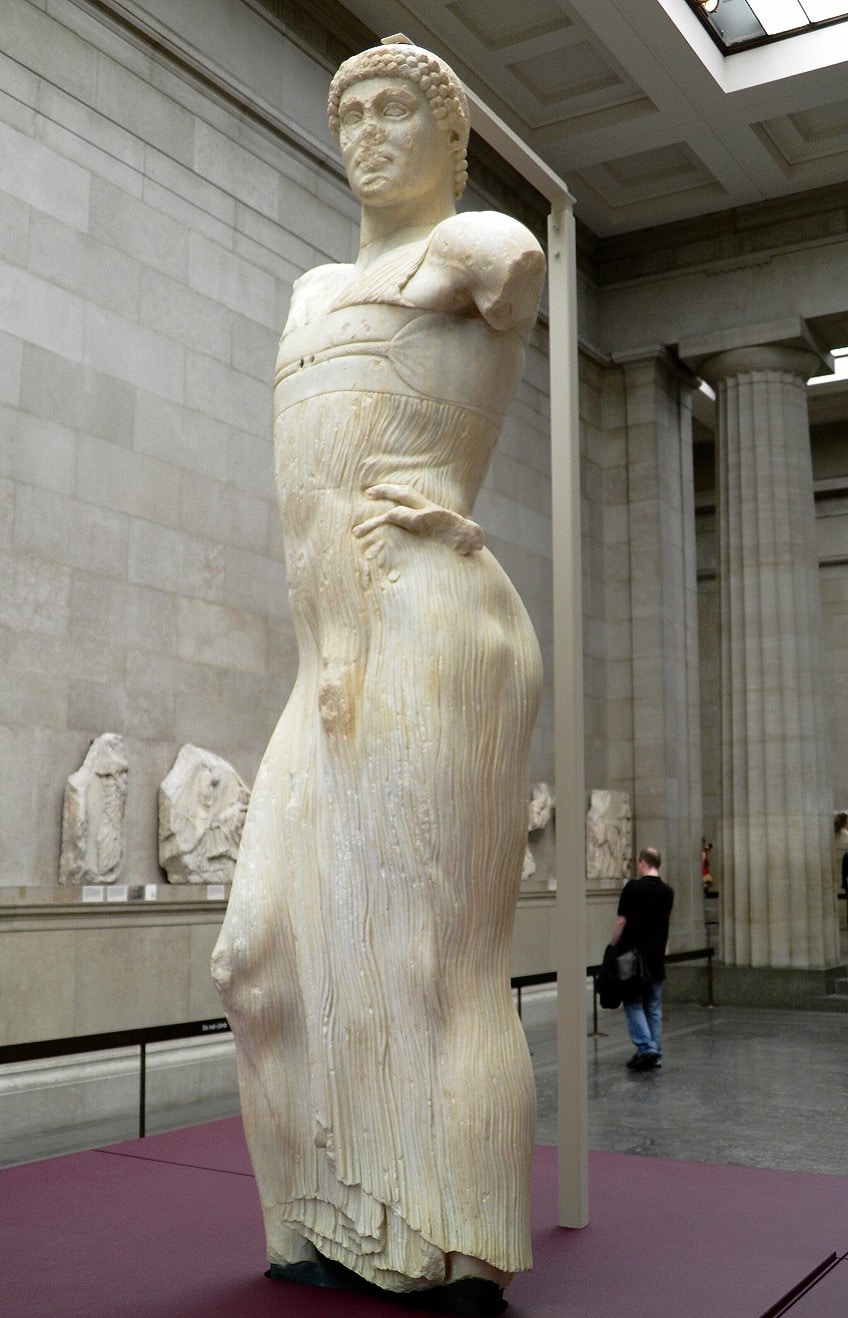 The Motya Charioteer, made by a Greek sculptor in Sicily, about 460-450 BC; Carole Raddato from FRANKFURT, Germany, CC BY-SA 2.0, via Wikimedia Commons
The Motya Charioteer, made by a Greek sculptor in Sicily, about 460-450 BC; Carole Raddato from FRANKFURT, Germany, CC BY-SA 2.0, via Wikimedia Commons
The Motya Charioteer is a life-size marble statue that depicts a young male character who is mostly in pieces at this point in time. He is depicted in a contrapposto pose, but his arms and part of his face are missing. This is because the statue collapsed at some point and part of it was damaged in the process. The statue is designed in such a way that the subject appears to be wearing thin fabric that is mostly see-through, such as being able to see his genitals and the veins of his skin beneath it. This light fabric design makes the Motya Charioteer one of the most superb statues of its kind to have been created.
In addition, the statue is actually not as damaged as it could have been. When the statue collapsed, it also lost its head. However, archaeologists were able to reattach it. The same is not true of the other missing limbs.
Artemision Bronze (460 BCE) from Cape Artemision
| Creator | Possibly Kalamis (around 470 – 440 BCE) |
| Date | 460 BCE |
| Materials Used | Bronze |
| Height | 2.09 meters (or 6.9 ft) |
| Discovery Location | Cape Artemision, Euboea, Greece |
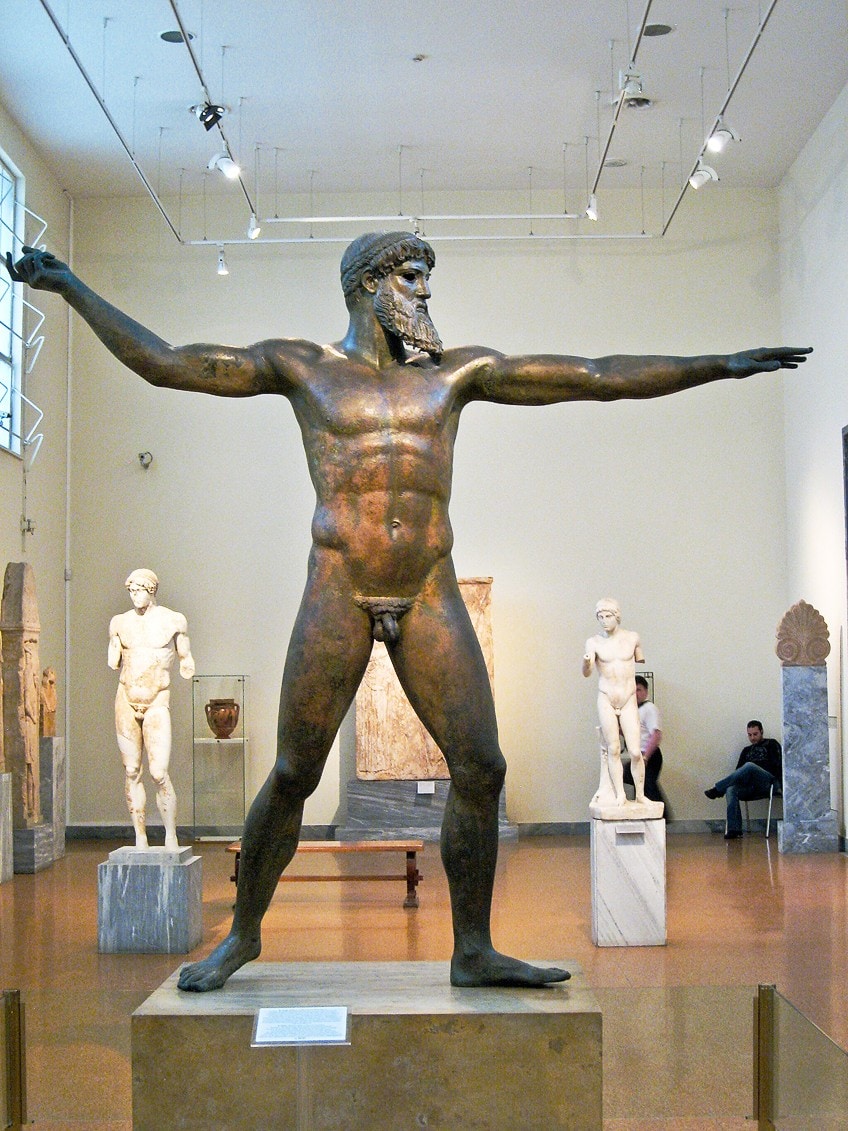 Artemision Bronze (460 BCE) from Cape Artemision; Sharon Mollerus, CC BY 2.0, via Wikimedia Commons
Artemision Bronze (460 BCE) from Cape Artemision; Sharon Mollerus, CC BY 2.0, via Wikimedia Commons
The Artemision Bronze is another of the famous Greek statues that were discovered in the ocean. Many of these ancient sculptures and pieces of art fell into the ocean over the years as shipwrecks were far more devastating and unsalvageable in the ancient era than they are today. It’s a lot easier to dive off the Greek coast today than it used to be. Either way, the exact sculptor of this particular statue is unknown, but there have been theories. The figure that is depicted in this bronze statue is a god, but whether the figure is Zeus or Poseidon is up for debate. However, common consensus considers it to depict Zeus. The reason for the confusion is because the figure has a raised hand that indicates something may have once been contained within it.
It could have been a thunderbolt (in which case, it would be a depiction of Zeus) or it could have been a trident (in which case, it would be a depiction of Poseidon).
Either way, the sculpture itself has not managed to retain its original design. The basic sculpture may have been made of bronze, but the eyes, lips, eyebrows, and nipples have not retained their original materials. A statue at the bottom of the ocean is unlikely to manage particularly well through the ages, after all.
Riace Bronzes (460 – 450 BCE) from Riace
| Creator | Unknown |
| Date | 460 – 450 BCE |
| Materials Used | Bronze |
| Height | 1.98 meters (or 6.5 ft) |
| Discovery Location | Riace, Calabria, Italy |
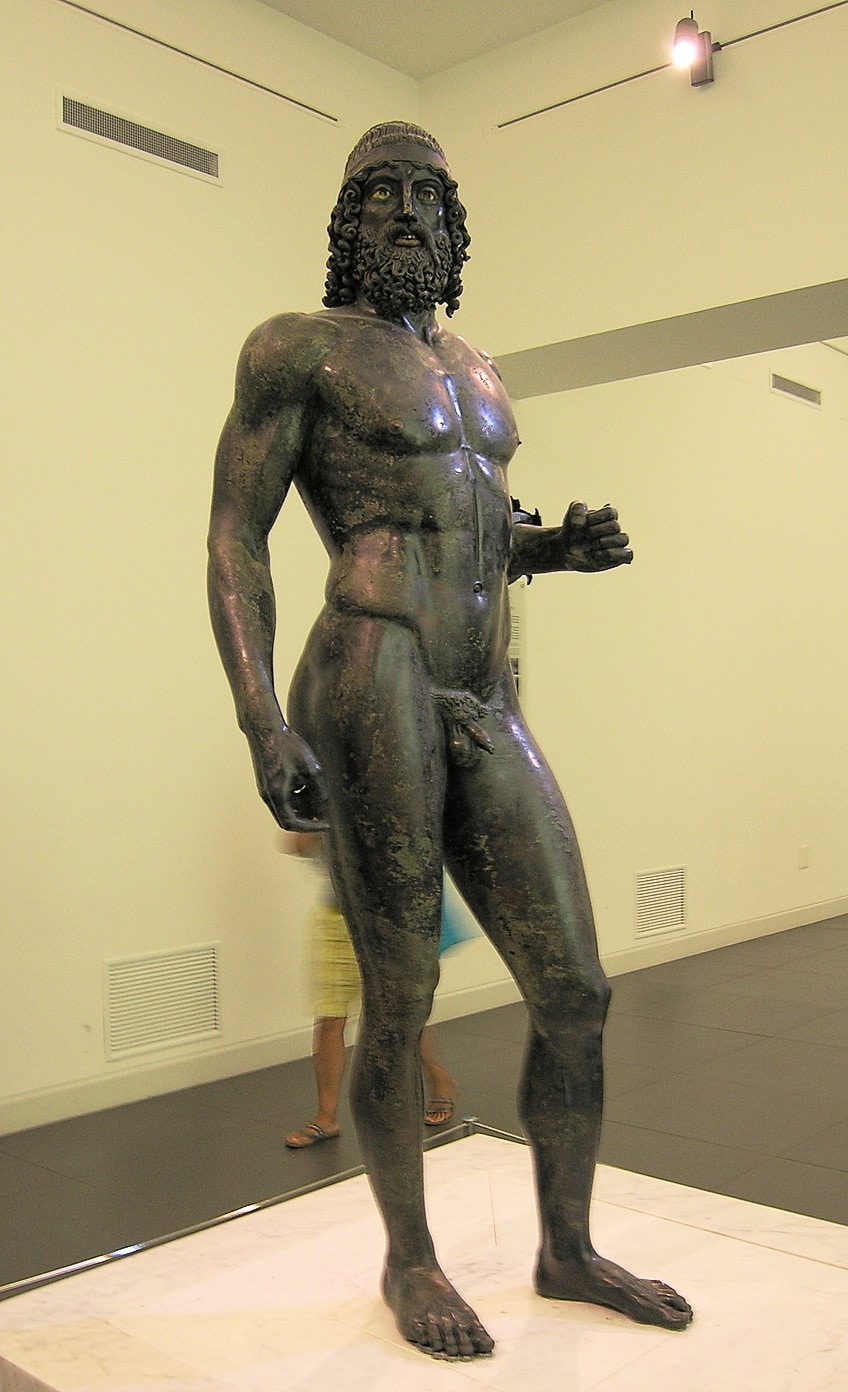 Riace bronzes – Statue A – National Archaeological Museum of Magna Graecia in Reggio Calabria – Italy; Luca Galli, CC BY 2.0, via Wikimedia Commons
Riace bronzes – Statue A – National Archaeological Museum of Magna Graecia in Reggio Calabria – Italy; Luca Galli, CC BY 2.0, via Wikimedia Commons
The Riace Bronzes are a pair of life-size bronze statues. In the case of these two figures, they depict two naked male warriors, and their initial location is not entirely known as they were found in the sea. They are some of the last surviving of this particular sculptural style as many of these full-size bronze statues were actually melted down for their bronze and reused in other settings. This is an unfortunate but common fate that befalls many such ancient Greek artifacts.
The two figures have been given the incredibly original names Statue A and Statue B, and they are very similar to one another.
They are both made using a sculptural technique known as the lost wax casting technique, which involves the design of a wax mold into which the statue is set. The wax mold is destroyed or lost, in the process (hence the name). It is uncertain who is depicted in these two bronze statues, but it has been suggested that they may depict Tydeus and Amphiaraus, who are two figures that formed part of the Seven against Thebes, a group of seven ancient Greek mythological figures who went to war against Thebes. However, it is not certain whether this is what is depicted within these two bronze statues.
Discobolus (460 – 450 BCE) from Unknown
| Creator | Myron of Eleutherae (working from 480 – 440) |
| Date | 460 – 450 BCE |
| Materials Used | Bronze |
| Height | 1.6 meters (or 5.2 ft) |
| Discovery Location | Lost |
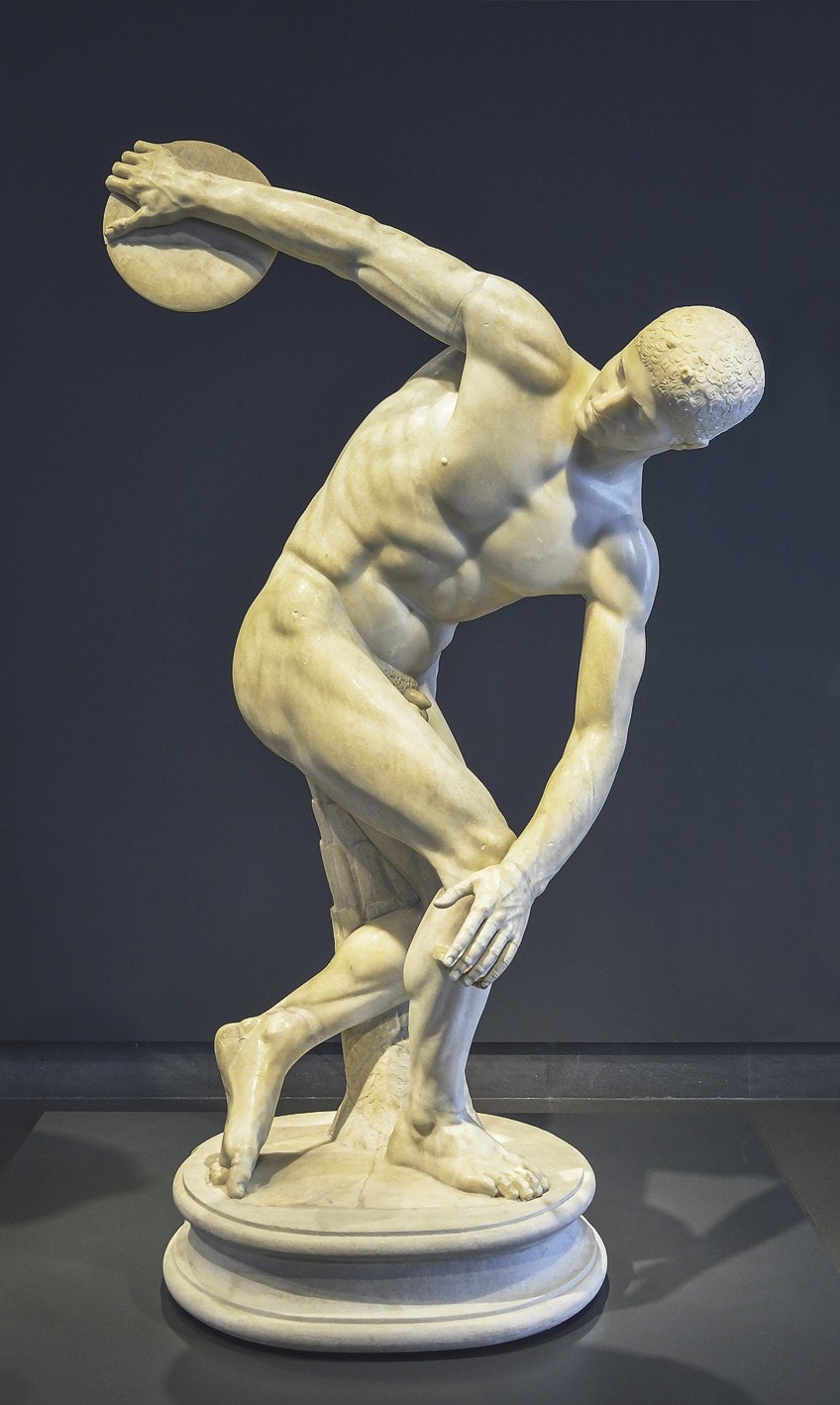 Roman copy of the Discobolus Palombara (460 – 450 BCE) by Myron, located in the National Roman Museum in Rome, Italy; After Myron, CC BY-SA 4.0, via Wikimedia Commons
Roman copy of the Discobolus Palombara (460 – 450 BCE) by Myron, located in the National Roman Museum in Rome, Italy; After Myron, CC BY-SA 4.0, via Wikimedia Commons
The Discobolus is, most definitely, one of the most famous Greek statues to have ever been designed. However, it is also rather interesting because the original bronze statue is actually lost. We have never had access to the original and we only know that it exists because the statue was considered to be such a classic image of ancient Greek culture and craftsmanship that it was extensively copied in Rome. There are numerous Roman iterations of this exact same statue, and some of them are made far smaller or retain the full height but use marble instead of bronze.
This figure has become one of the most famous sculptures designed by the already famous Greek sculptor Myron of Eleutherae.
The statue has also become an immensely iconic image because it is seen as the representation of the Olympic Games, both the original ancient Greek version of these classical games and the modern version (which was initially based on the ancient Greek model but has since strayed further and further from the initial design). The Discobolus depicts a figure in the midst of throwing a discus, and so it shows the importance of athleticism in ancient Greece and serves as an important piece of ancient Greek art because of the immaculate design that went into realistically portraying this figure in the middle of such an athletic activity.
Athena Parthenos (Mid-5th Century BCE) from the Acropolis of Athens
| Creator | Phidias (480 – 430 BCE) |
| Date | Mid-5th century BCE |
| Materials Used | Gold, ivory, and wood |
| Height | 11.5 meters (or 37.7 ft) |
| Discovery Location | Acropolis of Athens, Athens, Greece |
 Athena Varvakeion, a small Roman replica of the Athena Parthenos by Phidias; National Archaeological Museum of Athens, CC BY-SA 3.0, via Wikimedia Commons
Athena Varvakeion, a small Roman replica of the Athena Parthenos by Phidias; National Archaeological Museum of Athens, CC BY-SA 3.0, via Wikimedia Commons
The Athena Parthenos is a monumental statue of the goddess Athena. This famous statue does not actually exist any longer but was once a famous figure that was placed within the Parthenon. The sculpture itself is an example of a chryselephantine sculpture. This means that it was built around a base of some kind, in this case, a wooden one, and then layered with plates of ivory and gold to create a far more illustrious image than the kind that is usually created through sculptures. The massive statue, which would have been about 11.5 m (or 37.7 ft) in height, towered over all other statues and figures within the Parthenon and likely served as the central point within that structure. While the design of the statue is generally attributed to Phidias, it is known that many craftsmen had a grand in its creation, and it was considered to be one of the greatest such statues to have ever been built (although the next item on this list did somewhat steal its thunder, both literally and metaphorically).
We no longer have any pieces of the original statue, and we only know about its design through various copies that were made over the centuries. Either way, this ancient Greek sculpture was considered to be one of the most important in one of the most important ancient Greek structures.
Statue of Zeus (435 BCE) from Olympia
| Creator | Phidias (480 – 430 BCE) |
| Date | 435 BCE |
| Materials Used | Gold, ivory, and wood |
| Height | 12.4 meters (or 41 ft) |
| Discovery Location | Destroyed |
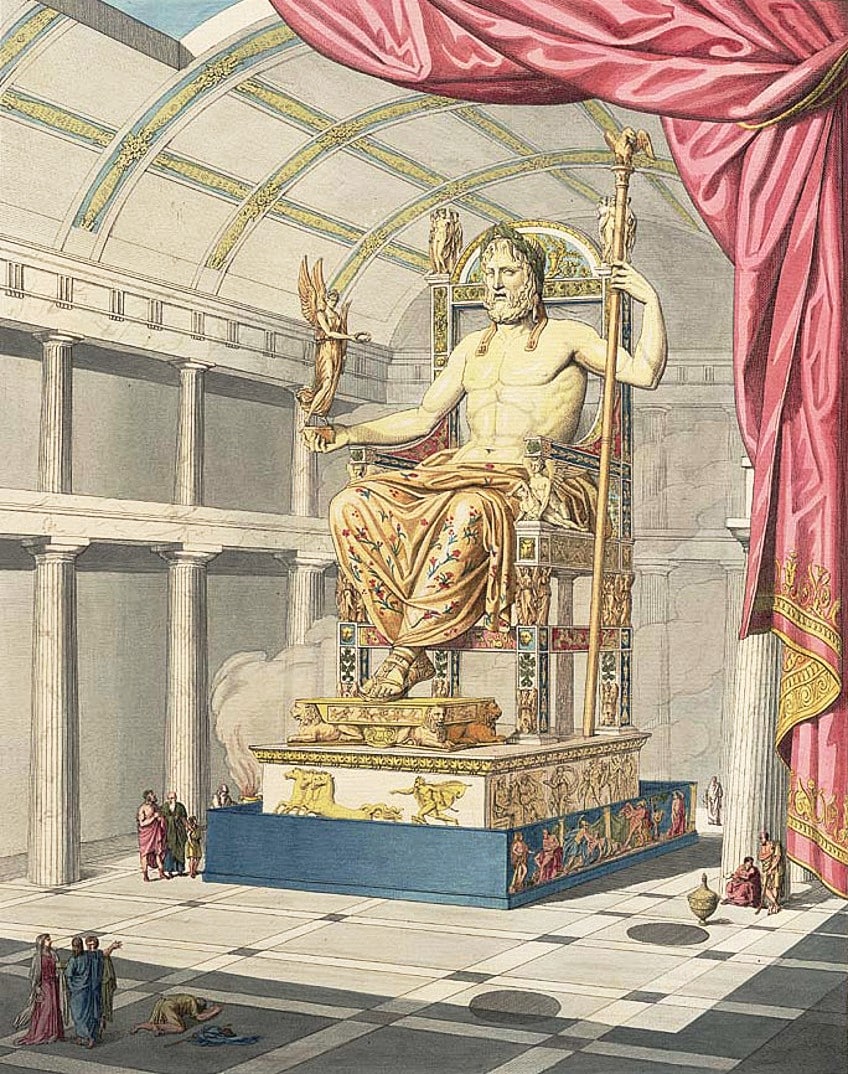 Zeus in Olympia; Quatremère de Quincy, Public domain, via Wikimedia Commons
Zeus in Olympia; Quatremère de Quincy, Public domain, via Wikimedia Commons
The Statue of Zeus at Olympia is most certainly one of the most famous statues to have ever been created. However, it also doesn’t exist anymore, and we only know about it through descriptions of it. We especially know about it because it was considered to be one of the Seven Wonders of the Ancient World. However, as its appearance is mostly through sources rather than direct observation, it isn’t the most famous Greek statue currently known. This particular statue was a monumental one that measured 12.4 m (or 41 ft) in height and depicted Zeus sitting on a throne. The statue itself was a chryselephantine sculpture, similar to the Athena Parthenos statue but larger in design. This means that the sculpture was made using a wooden interior with plates covering it made of ivory and gold.
This made the Statue of Zeus at Olympia one of the most ambitious and illustrious ever designed by ancient Greek sculptors.
This statue was found at the Temple of Zeus, but that temple, sadly, no longer exists. However, as we have ample evidence for its existence, it’s safe to assume that the Statue of Zeus at Olympia is one of the most famous Greek statues to have ever existed. It’s just a shame that no one is able to see it any longer.
Pediments of the Parthenon (Around 432 BCE) from the Acropolis of Athens
| Creator | Multiple, including Agoracritus (5th century BCE) and Phidias (480 – 430 BCE) |
| Date | Around 432 BCE |
| Materials Used | Marble |
| Height | 13.72 meters (or 45 ft) |
| Discovery Location | Acropolis of Athens, Athens, Greece |
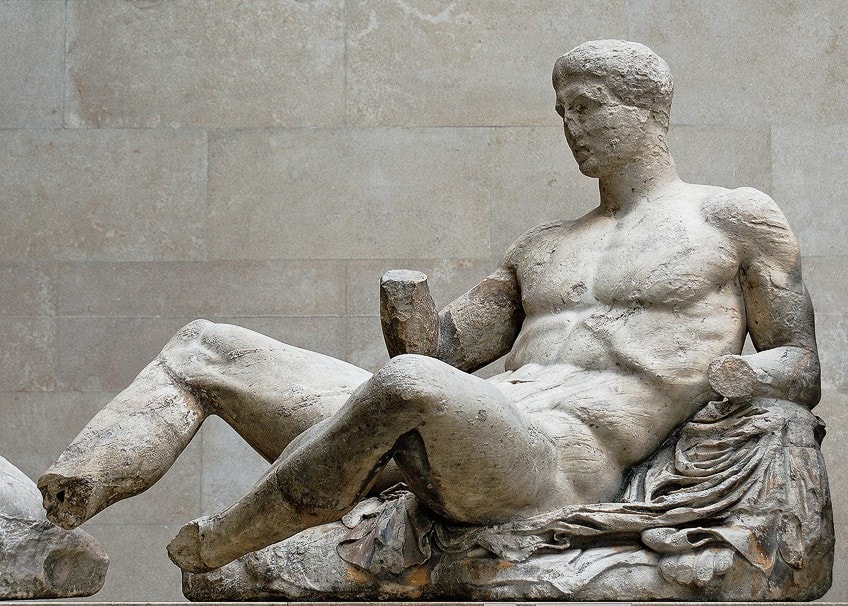 Reclining Dionysos, from Parthenon east pediment, ca. 447–433 BC; British Museum, CC BY 2.5, via Wikimedia Commons
Reclining Dionysos, from Parthenon east pediment, ca. 447–433 BC; British Museum, CC BY 2.5, via Wikimedia Commons
The Pediments of the Parthenon are some of the most famous instances of ancient Greek artifacts especially because of their connection to British colonialism. This set of sculptures, which is a long array of gorgeous and immensely important sculptures, was once part of the Parthenon, which is one of the most famous instances of ancient Greek architecture. However, these marble sculptures were pulled off the walls by Lord Elgin of the British Empire and later handed over to the British Museum (which is still in possession of them to this day).
The sculptural group is made up of multiple figures that have been slowly damaged over the years thanks to the slow march of time and the quick destruction of wars.
This group of statues is comprised of a series of mythical figures taking part in some of the most famous narratives within Greek myth. For instance, the western portion of this sculptural group depicts the grand dispute between Athena and Poseidon for Athens. This sculptural group has become something of a symbol for restitution in the modern era as there have been repeated calls for its return to Greece. The history of the Pediments of the Parthenon, along with the so-called Elgin Marbles, have become tied in with the history of British colonialism and colonialism as a whole to attain meaning that was never intended by the ancient Greek sculptors who originally created these grand marble statues.
Aphrodite of Knidos (4th Century BCE) from Knidos
| Creator | Praxiteles (4th century BCE) |
| Date | 4th Century BCE |
| Materials Used | Marble |
| Height | 2.05 meters (6.7 ft) |
| Discovery Location | Lost |
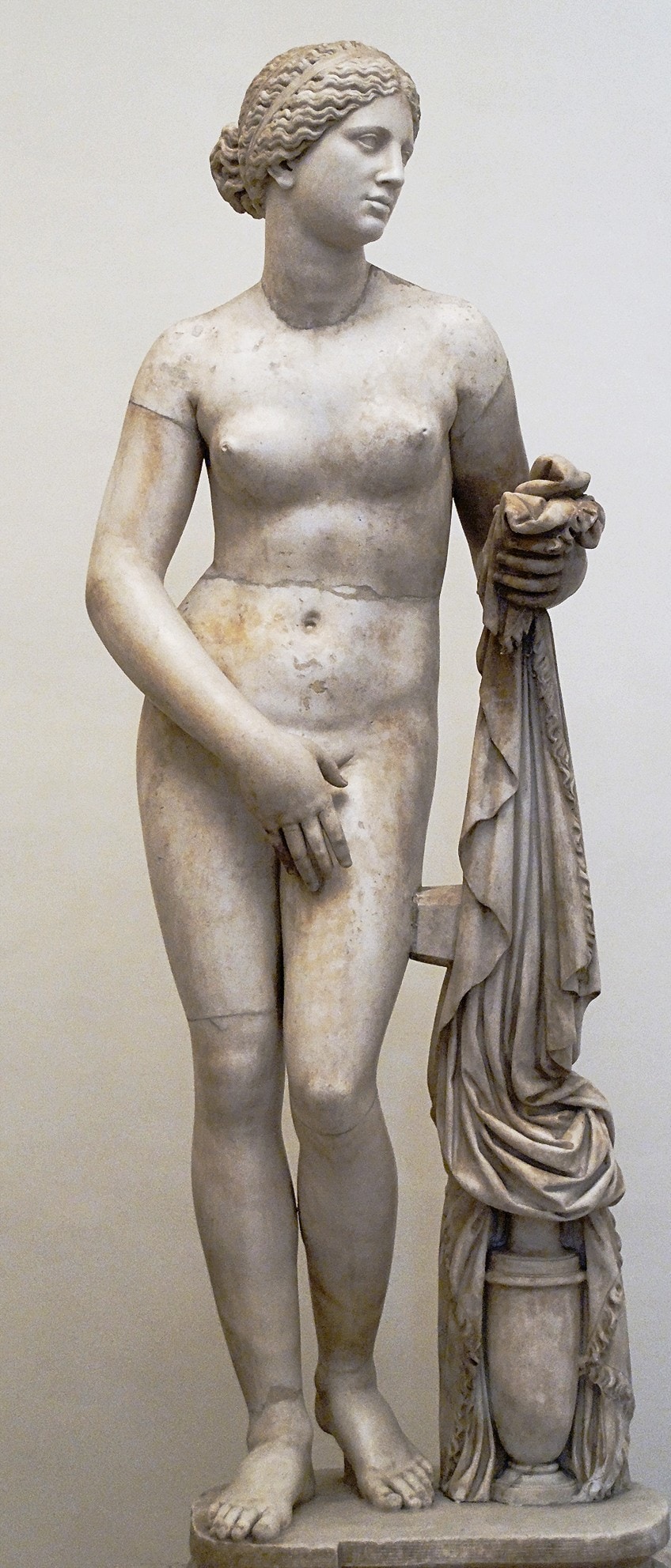 Aphrodite of Knidos; Museo nazionale romano di palazzo Altemps, Public domain, via Wikimedia Commons
Aphrodite of Knidos; Museo nazionale romano di palazzo Altemps, Public domain, via Wikimedia Commons
The Aphrodite of Knidos is one of the earliest instances of a Greek woman statue that makes use of full nudity. Nudity was a common feature in ancient Greek statues, and this was because the natural form was considered to be absolutely beautiful and worthy of artistic elevation. However, it was the male nude form that was generally elevated by Greek sculptors at the time, but this particular statue of Aphrodite revealed a change in this general trend.
This life-size statue of the god of love was commissioned as part of the Temple of Aphrodite at Knidos, and the figure of Aphrodite that is depicted with this statue shows that this ancient Greek god was preparing for a ritual bath as she throws aside the last of her garments.
Her one hand throws aside the last of her clothes while the other covers her groin area. However, this allows the upper portions of the statue to be further exposed. This particular statue of Aphrodite went on to become one of the most copied and famous Greek statues of the period, and its depiction of the female form was considered to be somewhat controversial for the time. It has retained its place as one of the most important ancient Greek artifacts for this reason.
Victorious Youth (300 – 100 BCE) from the Aegean Sea Coastline
| Creator | Possibly Lysippos (4th century BCE) |
| Date | 300 – 100 BCE |
| Materials Used | Bronze |
| Height | 1.96 meters (or 6.4 ft) |
| Discovery Location | Aegean Sea Coastline, Greece |
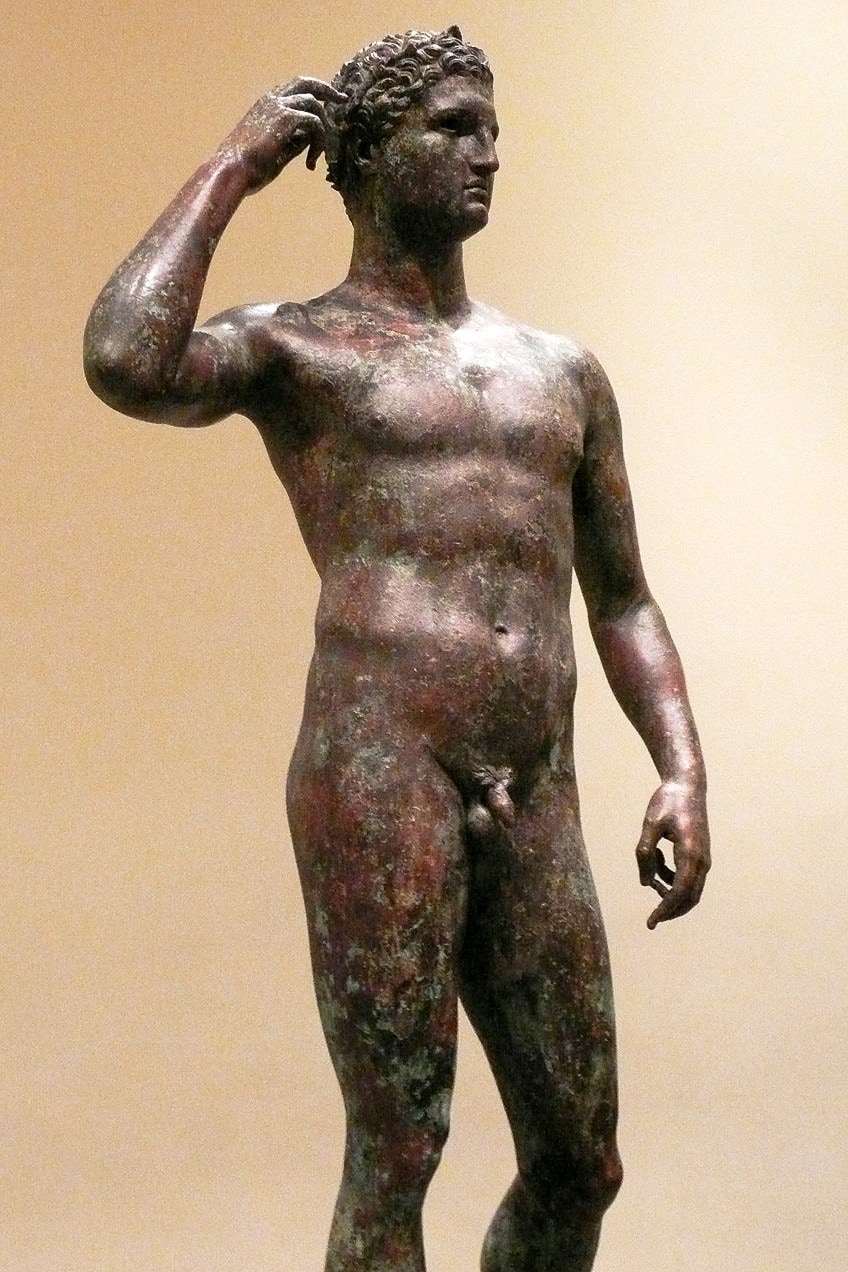 4th/5th Century BCE, bronze sculpture of Victorious Youth; Possibly Lysippos, CC BY-SA 2.0, via Wikimedia Commons
4th/5th Century BCE, bronze sculpture of Victorious Youth; Possibly Lysippos, CC BY-SA 2.0, via Wikimedia Commons
The Victorious Youth is one of the many bronze sculptures that have been found in the ocean, and in this particular case, the sculpture was only found in 1964. This sculpture is thought to have been part of a collection that showed various victorious athletes standing beside one another, but only this one remains at present. It was created through the lost wax method and cast as a single, solid piece of sculpted bronze.
There have been several arguments made that the figure who is depicted may have been related, in some way, to Alexander the Great, but there is no actual certainty with regards to this as there are no real records of this particular statue.
We can only go on what is depicted on the statue itself. The eyes of this ancient Greek statue would have once been inlaid with a separate material, possibly bone, and the nipples were constructed out of copper to produce a contrasting effect. However, we know little else about this particular statue, but it has gone on to become one of the most notable statues that depicts an ancient athletic figure.
Winged Victory of Samothrace (200 – 190 BCE) from Samothrace
| Creator | Possibly Pythocritos (210 – 165 BCE) |
| Date | 200 – 190 BCE |
| Materials Used | Marble |
| Height | 2.75 meters (or 9 ft) |
| Discovery Location | Samothrace, Greece |
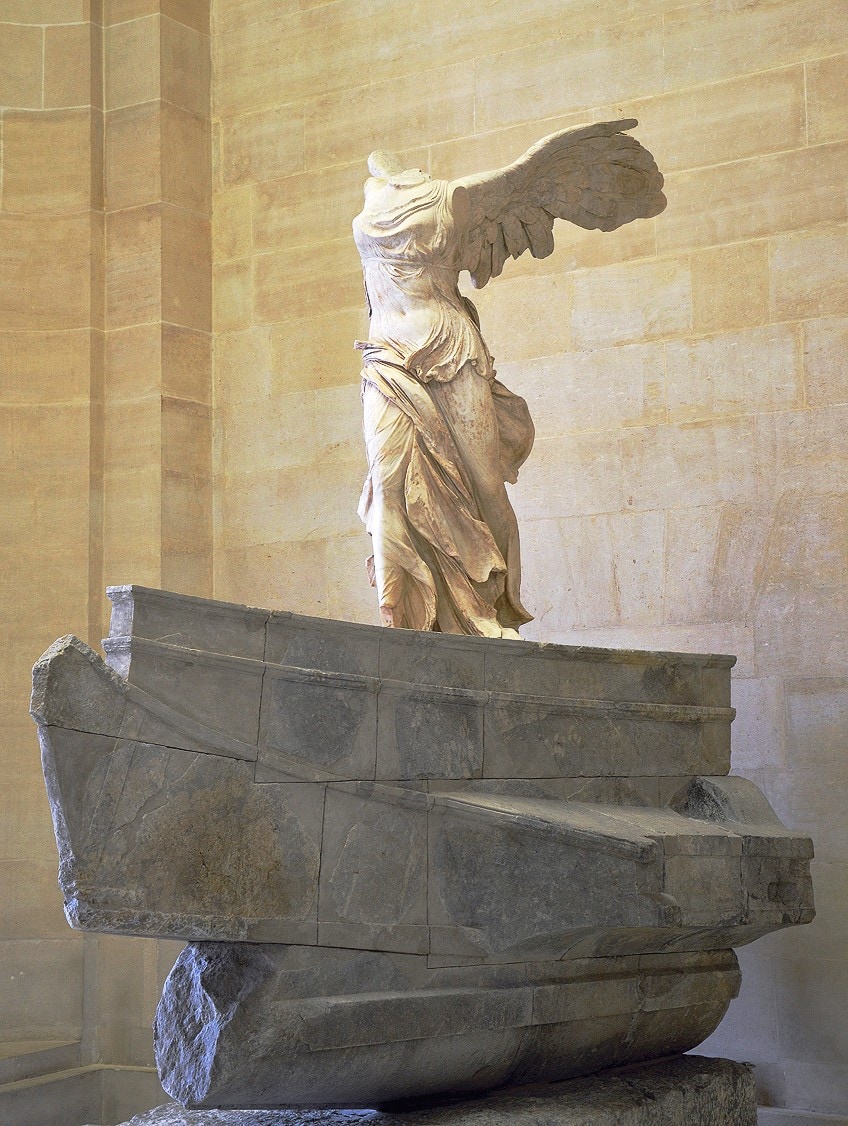 The Winged Victory of Samothrace; Louvre Museum, CC0, via Wikimedia Commons
The Winged Victory of Samothrace; Louvre Museum, CC0, via Wikimedia Commons
The Winged Victory of Samothrace is, by far, one of the most famous examples of ancient Greek sculpture. This particular statue is currently on display in the Louvre, where it has been for nearly a century and a half. The statue depicts Victory, the ancient Greek goddess, and it is considered to be one of the greatest masterpieces of the Hellenistic period. The statue itself is 2.27 m (or 7.4 ft), but the famous Greek woman statue is standing on a large plinth that further elevates the height by about double. The goddess is depicted with her wings intact as she appears to be at the conclusion of a flight.
The position of her wings indicates this even though her head and arms are no longer attached to the statue.
This sculpture has become one of the most famous Greek statues and an icon of the Hellenistic period. This is also one of the reasons that Greece has been pursuing the return of the statue, but France and the Louvre have, as of yet, made no efforts to return it. As it has been a fixture in the famous French museum for over a century, it does make sense that they would not want to return it even if it does not form part of French heritage.
Laocoön and His Sons (2nd Century BCE) from Rome
| Creator | Several |
| Date | 2nd century BCE |
| Materials Used | Marble |
| Height | 2.08 meters (or 6.8 ft) |
| Discovery Location | Rome, Italy |
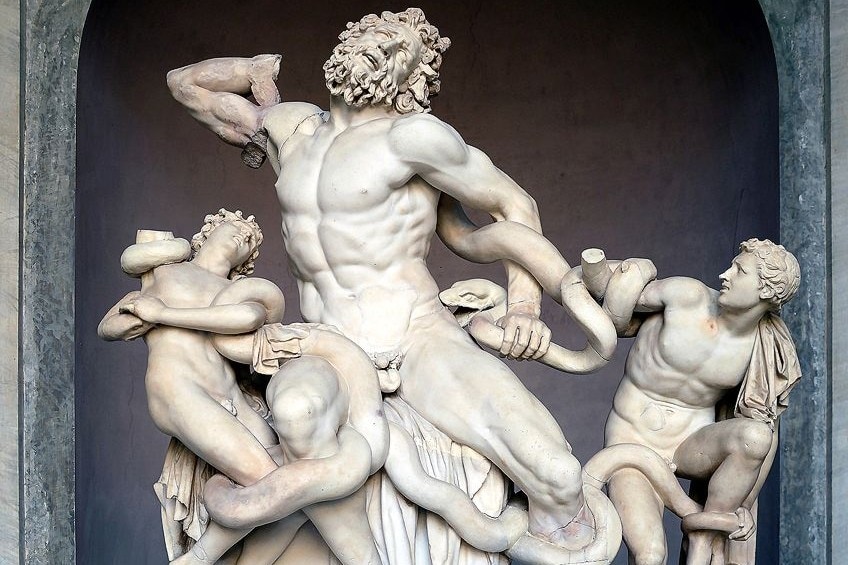 Laocoön and his Sons, also known as the Laocoön Group, (323 – 31 CE) by the Rhodesian Trio, located in the Vatican Museums in the Vatican City; Vatican Museums, CC BY-SA 4.0, via Wikimedia Commons
Laocoön and his Sons, also known as the Laocoön Group, (323 – 31 CE) by the Rhodesian Trio, located in the Vatican Museums in the Vatican City; Vatican Museums, CC BY-SA 4.0, via Wikimedia Commons
Laocoön and His Sons is another of the most famous Greek statues, and it has become one of the most famous icons of ancient Greece in general. This is also one of the oldest excavated statues as it was discovered in Rome in 1506 and has been in the Vatican Museum ever since. The statue stands at a full height of 2.08 m (or 6.8 ft), and so the central figure is roughly life-sized. The figures depicted include Laocoön alongside his two sons as they are attacked by monsters from the ocean.
These statues have become an integral part of the Western sculptural canon, and they were deeply influential in the creation of Christian artworks that depict similar levels of pain and suffering. In addition to being immensely influential as a sculpture, this statue has also retained its original condition with very few instances of damage (although there have been restorations performed on the statue over the centuries).
An interesting piece of history about this statue is that it is generally considered to be the statue that Pliny the Elder, the scholar and writer, praised in his works. If this is correct, then this sculpture was considered to be a masterpiece in its time and not only in retrospect.
Venus de Milo (150 – 125 BCE) from Milos
| Creator | Alexandros of Antioch (2nd – 1st century BCE) |
| Date | 150 – 125 BCE |
| Materials Used | Marble |
| Height | 2.04 meters (or 6.8 ft) |
| Discovery Location | Milos, Greece |
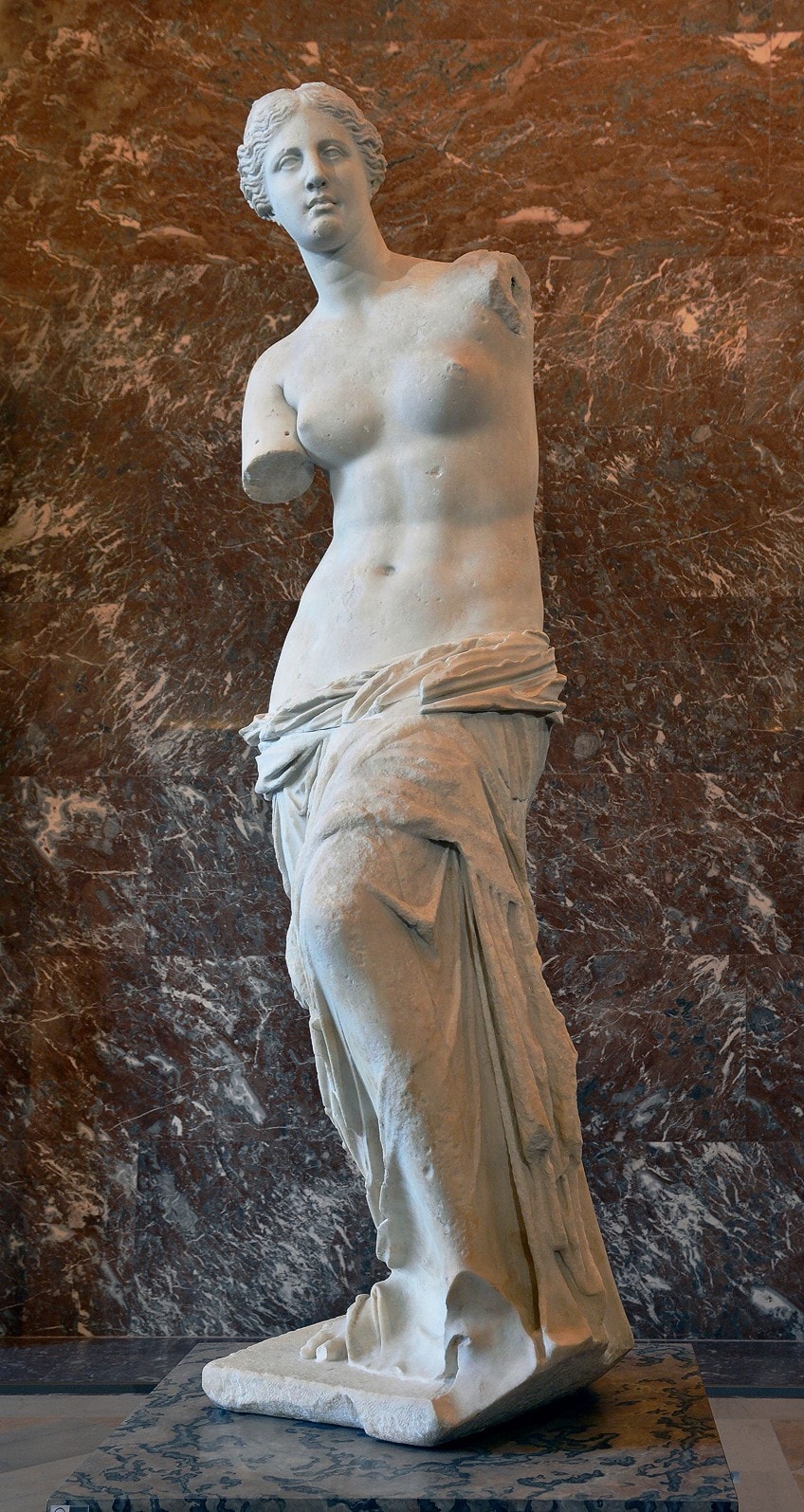 Front views of the Venus de Milo; Livioandronico2013, CC BY-SA 4.0, via Wikimedia Commons
Front views of the Venus de Milo; Livioandronico2013, CC BY-SA 4.0, via Wikimedia Commons
The Venus de Milo is, very likely, the most famous ancient Greek statue of all time. This Hellenistic sculpture has been on display in the Louvre Museum ever since it was rediscovered. The statue may be missing its arms, but the female figure is depicted in stunning and meticulous detail. The figure that is depicted is Aphrodite, the Greek goddess of love, but she has been named “Venus” because that is the Roman name for the same god (which is misappropriation but has remained the common term since its discovery).
This Greek sculpture has become an aspect of what is considered quintessential feminine beauty for the period, and it has had a profound impact on Western art ever since.
The large statue is made of marble and has been the subject of numerous pop cultural references. This particular sculpture has been repeatedly referenced, parodied, and discussed in various films and other pieces of media. The Venus de Milo is from a later period of ancient Greek culture, yet it has become one of the most famous instances of ancient Greek art.
We have come to the end of our look at famous Greek statues. These ancient Greek statues were often created by some of the most famous Greek sculptors and are considered to be some of the most important ancient Greek artifacts that have ever been discovered. In this article, we looked at fifteen of the most famous Greek statues and, hopefully, you’ve learned a good few things along the way, but there is always more to learn!
Frequently Asked Questions
Why Are Greek Sculptures So Famous?
The ancient Greek civilization is, in many ways, considered to be part of the foundations of Western civilization. The ancient Greeks and the later Romans are often considered together in this regard. For this reason, the art and architecture of these two civilizations are considered to be some of the most important to the development of later forms of art and architecture. Ancient Greek artifacts and statues are so important and famous because they represent the beginnings and refinements of many artforms.
Which Greek Statue First Used Female Nudity?
There are several statues that could claim this particular mantle, but the Aphrodite of Knidos is considered to be one of the most famous Greek women statues to have ever been created. It was one of the first to make use of female nudity, especially in a life-sized capacity. This is because male nudity was generally the dominant form used by ancient Greek sculptors. However, some of the most famous ancient Greek statues do make use of the female nude.
What Is the Most Famous Ancient Greek Statue?
In all likelihood, the most famous ancient Greek sculpture is also a Greek woman statue: the Venus de Milo. This incredibly famous and influential sculpture was produced during the Hellenistic period and has become a staple of the Louvre Museum in Paris. This famous Greek statue is missing its arms and its original plinth. The broken image of this famous ancient Greek statue has become representative of the country and the ancient Greek period as a whole.

I am deeply passionate about history and am constantly fascinated by the rich and complex stories of the past. As the editor-in-chief of learning-history.com, I have the opportunity to share this passion with a wide audience through the creation and distribution of engaging and informative content about historical events, persons, and cultures. Whether it’s through writing articles and blog posts or creating videos or podcasts, I strive to bring the past to life in a way that is both accurate and enjoyable. My expertise in history, combined with my strong writing and communication skills, allows me to effectively communicate complex historical concepts and make them accessible and interesting to a wide range of readers. I am truly grateful for the opportunity to share my love of history with others through my work on learning-history.com.


